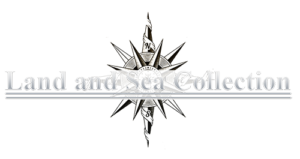VERY RARE C. PLATH HILGENDORF SEXTANT Ca 1896
Presented is an antique “NACHTBEOBACHTUNGEN” (NIGHT)
sextant, Hamburg, Germany at the turn of the 19th
Century. It is a very rare instrument that was conceived by Kaptain Robert Hilgendorf,
(1852-1937) Master of the Flying P Line’s five-masted bark POTOSI, at the time of its design.
It was specifically for night observations.

On October 26, 1896, he presented his findings to the Hamburg Nautical Association in the form of a sextant
made for him by C. Plath. The instrument incorporated an extended horizon mirror with a much larger clear section that
allowed much more of the horizon to be seen. It also used a telescope with a larger objective lens and a
wider field of view that transmitted more light to the observer’s eye. Both these modifications made sight-taking from
a pitching deck in the evening more accurate. Since the instrument was primarily to be used at night, only a single index
shade was fitted and no horizon shades were considered necessary. 
The members of the association, after examining and testing
the instrument, found it to be a “highly progressive step and a considerable improvement on previous instruments.” This information
was published in Plath’s Catalog No. 5, Ca 1902. See the engraving of the instrument as it appeared in the Plath catalog sheet
below. Robert Hilgendorf was considered the most
famous German 20th Century sailing master and is credited with record passages in several ships. See
Even with this sponsorship, the sextant met with little interest
and production ceased after only a few were made according to Peter Ifland in his book, “Taking the Stars”, thus making this
instrument even more valuable as a collectors item.
CONDITION: The sextant is in
its last used condition having been maintained by someone who took great care since it shows absolutely no corrosion
of its metal parts and elsewhere is in like new condition including the original varnish on its fittings. Unfortunately,
the ocular lens of the magnifier is cracked, but still useable. The gradations of the arc are engraved on a platinum insert
to reduce tarnish.
The mirrors are clear, sharp, and with only a couple of small blemishes
and one minor break in the silver of the horizon mirror. The Rosewood handle is nicely finished.
The index arm clamp is complete
and in good working order. The frame is finished in its original arsenic black coating without blemish. It
is fitted with an original daylight telescope which mounts using a screw-in disk that has the diameter
of the night scope which is not included There is no certificate which is not unusual with older instruments. However,
in testing, the index and side error were found to be negligible.
MARKINGS: The C. Plath “stick man” logo
is engraved on the arc’s left corner. Just above it is engraved 6469 the same number as on the case. C. Plath, Hamburg is marked
at its center. At the top of the index arm, just below the index mirror are the initials, H.A.L. The case has an old style
C. Plath plaque inside. The telescope is by Wetzlar an early binocular maker who became part of Zeiss. The bronze arc is calibrated -5 to 115 degrees with a vernier that reads from,
right to left, 0 to 20 seconds of arc. THE CASE: The instrument is housed in a fitted Pinewood carrying case, marked 6469, which has varnished
brass fittings. The number 6469 is imprinted on the case, and none on
the sextant. The lock has no key. The case is in good strong condition, but an age crack on the top has
been filled with wood putty. This does not affect its integrity, only its looks. There is a wood block whose purpose
is unknown and the small pick used to adjust the mirrors is missing. The adjustment can be made using a needle.
Outside of an engraving, this is the only C.Plath Hilgendorf’s
Night Sextant we have ever seen. One is noted in the definitive work on the topic of sextants, “Taking the Stars”
by Dr. Peter Ifland, and is also prominently shown in Plath’s own book, “From Sextant To Satellite Navigation, 1837 –

horizon mirror


SPECIFICATIONS: SEXTANT SN 6469:
</Length of index arm 9
1/2″Width of arc
8″Index Mirror
47 mm x 30 mm Horizon Mirror 62
mm x 32 mm
SEXTANT WEIGHT
3 LBS
CASE 10
1/4″W x 10 1/2″ D x 6 5/8″ H WEIGHT 8 lbs
Rarely do you find a historic instrument that
is 111 years old in this original condition with an exceptional pedigree. A superior addition to any collection.



